
So you need a locum. You know it. Your team knows it. But the approval process likely involves other decision makers. It is common for a practice to request locums support, only for directors to decline, preferring to have their full-time staff make do despite the shortage.
You can improve your odds for success by working with the practice or service line to gather all the necessary justification for the position, such as budgets, schedules, and patient volume.
You will also benefit from a firm understanding of the approval process. Who has the authority to request coverage? Who signs off on the dates the provider will work? Do not waste time petitioning those who have no say in the matter — it is best to make a convincing pitch to the right people at the right time.
Getting started with your physician search
Once you have received the green light, it is time to start your search. You will avoid a lot of headaches down the road by always having the details worked out before contacting a locum tenens agency. These details include:
- Date to start
- Length of assignment
- Detailed job description (this includes expectations, what procedures are required, typical cases they would see, how many people in the practice, what kind of call, etc.)
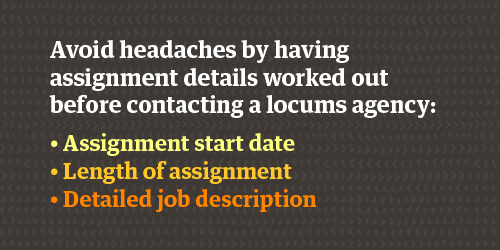
As you prepare these details, it can be helpful to ask for the agency’s practice description documents so you can ensure you get all the relevant details from the practice.
You will work closely with your agency contact to make sure they can go into market swiftly and accurately. If the assignment requires any special procedures that are out of the norm, make sure to lead with those details in your job description. The agency recruiter must clearly understand that those procedures are essential, not “nice-to-haves.”
Vetting locum tenens candidates
Once the locums agency has delivered candidates, review each CV for the following details before presenting a candidate to the practice or organization for consideration:
- Identity
- Education and training
- Residency
- Proper licensing
- Specialty certificates
- Career history
- Malpractice history
- Recent references
- Candidate-meets-hospital requirements
You will not have access to the National Practitioner Data Bank, but you can do a quick Google search to look for red flags on the candidate’s license. Go a few pages deep in the search results to see if any disciplinary action shows up. You should also visit the state licensing board website to confirm there are no marks on their license.
Additionally, you can ask the agency for references on the candidate. If the candidate has worked for the agency in the past, you can have the candidate authorize a release of assignment feedback from previous locum assignments. It is also helpful to visit ABMS.org and certificationmatters.org in order to verify the provider’s board certification.
If you have concerns about the candidate, you should not move forward.
Hire efficiently: Common mistakes recruiters make when hiring locums (and how to avoid them)
Making the initial screen really count
Now that you have selected one or more candidates, you will need to schedule an initial screen. This is your chance to glean as much information as possible. Your most important task is to ensure the candidate’s:
- Quality and qualifications
- Ability to fit in with the team at the facility
- Desire to be part of the team at facility
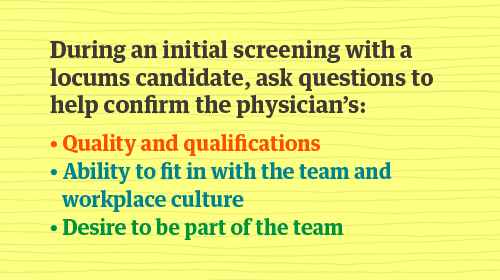
Be on the lookout for lone wolves, as the provider must want to be part of the culture and be ready to contribute. You will want to know if they have done locums before. There is a unique skill set and mindset for locums, so those who have done it successfully in the past are probably more likely to be a good fit than a newbie.
These screens have traditionally been done over the telephone, but that makes it hard to gauge the candidate’s quality and abilities. Video technology is so good and user-friendly that it is not intimidating to people (you can even do videos from your smartphone).
By using video chat for your initial screen, you can better gauge the candidate’s communication skills and empathy. Ask lots of questions and learn as much as you can. Be wary of candidates who seem too arrogant to answer your questions or simply offer quick responses.
When you are under a tight timeline, you can do this first call with the lead provider or simply let the lead provider conduct the call. Just be sure to tell the provider in advance. Setting expectations is an important way to help the provider feel comfortable and ready to open up.
After confirming the provider has the skills and certifications necessary, you can pass their CV to the decision maker. If approved, the credentialing process transitions to the medical staff office (MSO). The locums company will request the application and begin working to credential the provider, while you monitor the situation. It is important to have a good relationship and communication process with the medical staff office. This allows you to anticipate issues and get the provider to the facility when necessary.
What is the credentialing process for locum tenens?
The answer to this question varies depending on the size and capabilities of the agency. If you want to streamline things and get the best results, you should only work with experienced agencies that have robust processes in place. Speak with your agency contact to understand their process and determine an estimated timeline. Make sure everything will be attainable, as you do not want to have to delay a start date (and potentially impact patient care) due to an unrealistic timeline.
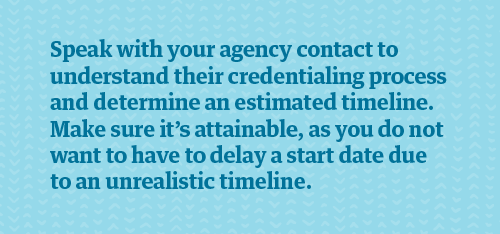
When such agencies confirm a provider, their medical staff services (MSS) team will credential them to JCAHO standards for their malpractice coverage. This entails gathering many of the documents your hospital will need as well, and they will often share them with you to expedite the process.
The main purpose of locum tenens credentialing is to confirm the provider’s professional training and experience by obtaining and evaluating qualifications. This is done by verifying the following through primary sources:
- Identity
- Education and training
- Residency
- Proper licensing
- Specialty certificates
- Career history
- Malpractice insurance
- Candidate meets hospital requirements
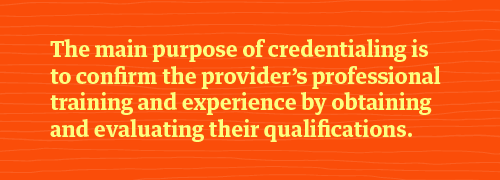
The best agencies have dedicated hospital privileging teams that will assist your medical staff office (MSO) in getting what it needs. These agency experts serve as liaisons between the medical staff office and the provider. They will ensure you get what you need, answer questions, and limit the back-and-forth communication.
When an agency’s MSS team is efficient, they can sometimes complete the locum tenens credentialing in as little as a week. This is only possible if the provider is responsive and quickly turns around paperwork.
The process moves must faster if the provider is already credentialed with the agency, because the MSS team can immediately begin prefilling the client’s privileging app with the information they have on file for the provider.
What is the privileging process for locum tenens physicians?
The MSO will use three areas of verification to match requirements. There is a lot of paperwork involved with privileging, so you will want to keep in close contact with the medical staff office so you can keep things organized and moving forward.
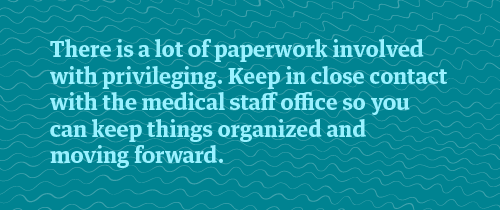
If the provider has worked prior locums assignments with the agency, the agency can often help speed things up. They would request the application and then work with the candidate to get the privileges documentation filled out. The goal is to confirm the provider’s:
- Diagnostic and treatment capabilities
- Training and experience
- Credentials are in order
If your timeline is tight and the provider has a clean application with no red flags, they can sometimes get temporary privileging. This arrangement is only possible with sign-off from the key stakeholders. You will need to speak with your MSO to understand the process for temporary privileges so you can ascertain if it is even an option. Background checks help to rule out any candidates who have negative sanctions. Here are the three databases most frequently used:
- National Practitioner Data Bank (NPDB)
- Board Action Data Bank of the Federation of State Medical Boards (FSMB)
- American Medical Association Physician Masterfile (AMA)
After all this information has been collected and verified, it is sent for review by the medical staff committee or other governing body. Stakeholders vary by health system but usually include some or all of the following:
- Department chair
- Credentials committee chair
- Credentialing committee
- Medical executive committee
- Chief Executive Officer (CEO)
- Governing board
- Chief Medical Officer (CMO)
- Chief of Staff
Think outside the box: 6 creative ways to overcome staffing challenges
Potential credentialing challenges to watch for
One of the most common issues that arises is receiving incomplete information from the applicant. You can help avoid this by working with a reputable agency that will communicate clearly with the provider and help to keep everything organized. Credentialing software can make everything better by securely archiving all the requests, information, and verifications.
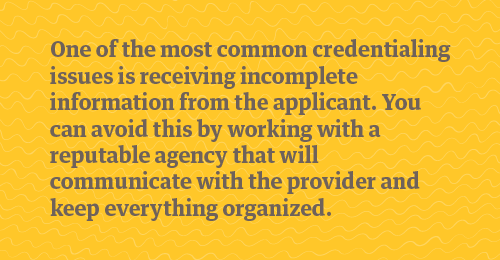
Another problem is being presented with a basic candidate who does not have the qualifications necessary for the assignment. When you need a provider who can perform a specific task, make sure this is crystal clear to the locums agency. Otherwise, you may be presented with a lot of “this person might work” situations.
The quality of candidates will always vary by agency. You can potentially save money with some lower-priced agencies, but those gains are lost if the agency turns out to be disorganized, or worse, dishonest. It all comes down to how well they vet their candidates, handle their credentialing, and support your MSO on credentialing.
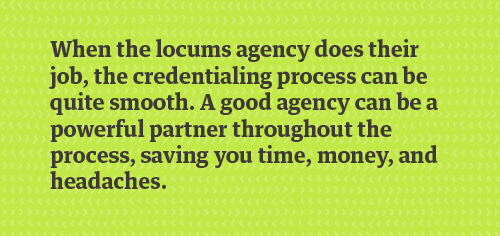
When the agency does their job, the credentialing process for locum tenens can be quite smooth. Just remember to keep your communication channels open so that you can identify obstacles and keep things moving in a positive direction. A good agency can be a powerful partner throughout the process, saving you time, money, and headaches.
Additional locum tenens credentialing resources:
Download our credentialing guide by clicking below:
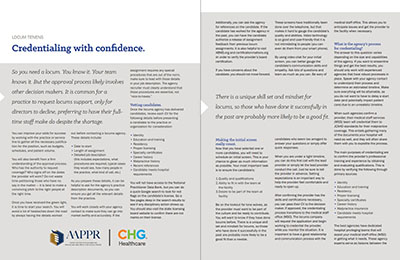
Click image to download PDF version
CHG Healthcare has the doctors, nurses, and allied professionals you need to help staff your facility. To learn more about our staffing solutions, give us a call at 866.588.5996 or email ecs.contact@chghealthcare.com.